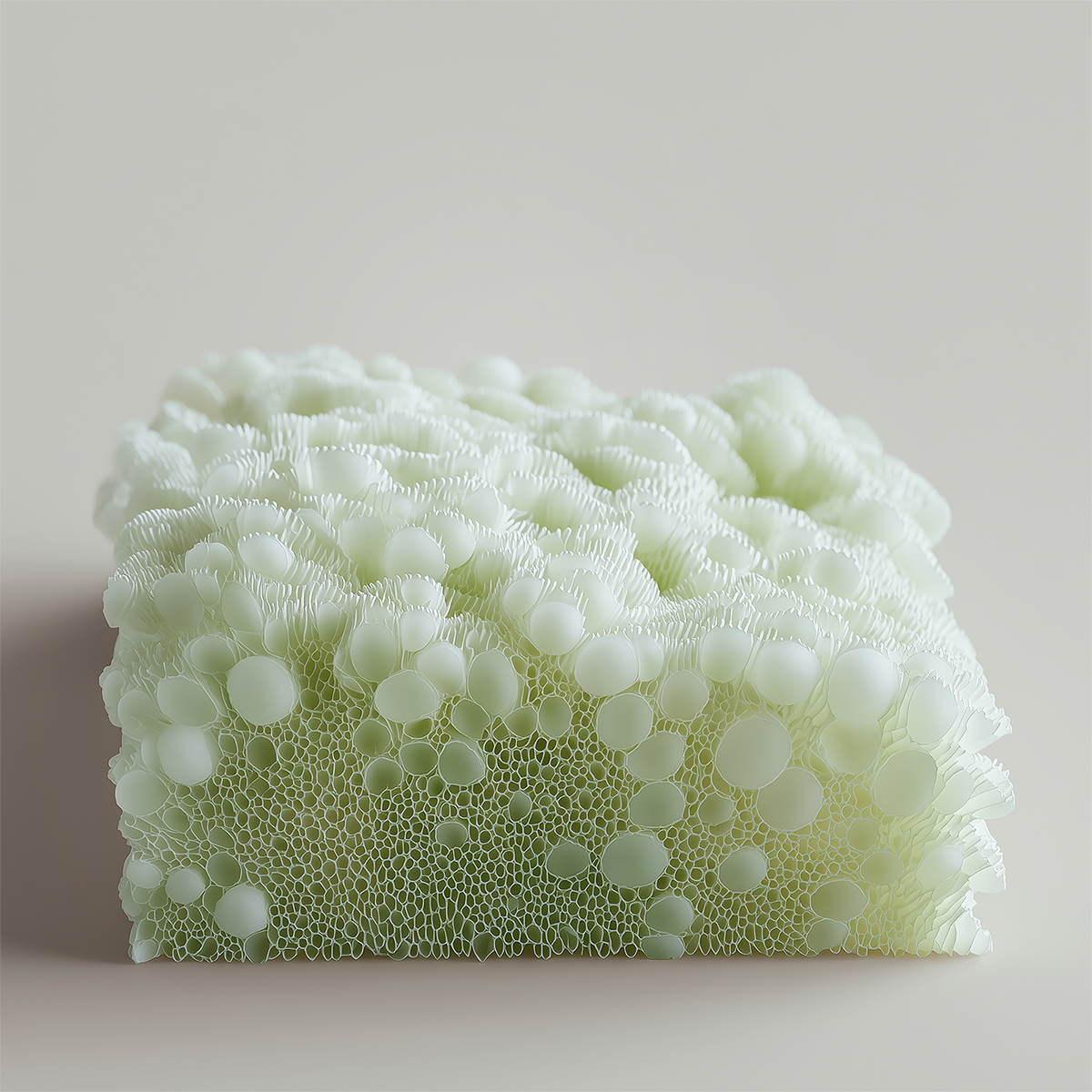Scent of the Unreal
Artificial intelligence and fragrance design meet to imagine new sensory experiences.
Among all our senses, smell stands out as the most ancient and mysterious. It bypasses rational thought, making its way directly into the limbic system, where memory and emotion are deeply connected. Just a single whiff can transport us through time — the scent of sun-warmed skin in a summer embrace, the earthy aroma of fresh soil after rain, or the faint trace of a beloved perfume lingering on a scarf tucked away for years. Smell doesn’t just evoke a moment; it brings it back to life, filling our memories with vivid detail. It can soothe, awaken, or unsettle — wielding the extraordinary power to alter our perception of time.
Yet, for all its intimacy, the essence of smell remains elusive. It has no fixed form — it drifts, fades, and returns, never quite the same twice. Unlike sight or sound, smell resists capture and measurement. We try to describe it, but language slips away. Scent exists somewhere between chemistry and emotion, between air and memory — a phenomenon that is both material and immaterial.
Even in perfumery, where fragrances are carefully composed from natural and synthetic ingredients, we can still tell when something feels artificial. The nose — whether human or otherwise — is finely attuned not only to ingredients but to authenticity. It senses the warmth, texture, and subtle imperfections that make a scent feel alive. Across species, smell remains one of the most primal and intuitive forms of intelligence — a sensory bridge linking bodies to environments, and memory to matter.
For decades, technology has tried to translate this invisible world — and failed. We can capture images as pixels, record sound with perfect clarity, even generate new materials through artificial intelligence. But scent has always resisted being fully digitised, reminding us that intelligence is not only about thinking but also about sensing.
The Technology of Smell: What Is Changing
That resistance, however, may be beginning to shift. In recent years, scientists have started exploring what they call olfactory intelligence — the use of artificial intelligence to decode and reproduce scent. Unlike vision, which works through just three colour dimensions, or hearing, which is based on frequencies, smell operates through hundreds of receptors working in unpredictable combinations. Mapping them has long been one of science’s greatest challenges.
Now, with the help of deep learning and neural networks, researchers are beginning to understand how molecular structures correspond to scent perception. Using instruments such as gas chromatography–mass spectrometry, they can “capture” the composition of a fragrance, translate it into data, and train AI models to predict how it will smell. The result is a kind of digital map of scent — a new sensory database where machines learn the relationships between molecules and emotions.
This emerging field is already transforming several industries. In fragrance design, artificial intelligence can suggest new ingredient combinations in days rather than months. In healthcare, scent analysis is being tested to detect illnesses through breath. And in environmental science, “digital noses” are being developed to monitor air quality and detect pollution long before humans notice it.
But these innovations also raise deeper questions. What happens when one of our most intimate and emotional senses becomes measurable, storable, and reproducible? Can something so bound to the body really be turned into data? And what might this mean for how we experience — and design — the world around us?
Where Design Meets Sensory Intelligence
This is where Scent of the Unreal, the collaboration between designer Lyse Martel and fragrance scientist Klio Maniati, finds its resonance. While scientists in laboratories are teaching machines to recognise and replicate smells, Martel and Maniati explore another path. They use artificial intelligence not to simulate scent, but to imagine new sensory experiences altogether.
For Martel — who works at the intersection of colour, material, and finish design — AI becomes a partner in speculation. She uses generative systems to create metamaterials: visual renderings of surfaces that appear otherworldly, layered, and ambiguous. These images are not literal representations of real substances. They are imaginative provocations — materials that behave like living organisms or hybrid ecosystems. Some shimmer like translucent skin, others seem to breathe or dissolve.
In these visuals, Martel is not designing objects but possibilities. Each AI-generated surface functions as a sensory hypothesis — an invitation to wonder how materials of the future might look, behave, and perhaps even smell.
Here is where Klio Maniati’s work enters. Rather than treating Martel’s images as inspiration for fragrance marketing, Maniati approaches them as emotional compositions. She reads the images intuitively — their colours, densities, rhythms — and translates them into bespoke scents. A crystalline surface might become a mineral accord; a dense, organic form might reveal smoky or humid undertones. Her interpretations are not literal but atmospheric, giving the digital images a sensory echo that the machine itself could never produce.
Together, these two perspectives create a dialogue between artificial and human intelligence — between the algorithmic generation of images and the embodied interpretation of scent. The result is a multi-sensory installation where vision meets olfaction, and the immaterial imagination of AI meets the visceral immediacy of smell.
What makes Scent of the Unreal remarkable is that it redefines what it means to design with AI. Instead of using technology to automate creativity, Martel and Maniati use it to amplify perception. The project does not position AI as superior to human or non-human senses but as an extension of them — a way to stretch the boundaries of material experience into emotional and sensory dimensions.
At first encounter, Scent of the Unreal feels poetic, even otherworldly. But beneath its delicate surfaces lies a critical reflection on how technology is reshaping the sensory world.
Smell is tied to emotion, place, and identity. It cannot be standardised without losing something of its essence. The project’s strength lies in acknowledging this paradox. By pairing AI’s generative power with the fragility of scent perception, Martel and Maniati show how technological progress and sensory understanding can coexist — not in opposition, but in conversation.
The work also challenges the hierarchy of the senses in design. For centuries, sight has dominated how we create and consume — from architecture to digital interfaces. Scent of the Unreal reminds us that intelligence is not only cognitive, but also perceptual. Machines may simulate thought, but the senses remain our most immediate way of knowing the world.
Looking to the Future: Materials, Senses, Intelligence
The ideas explored in Scent of the Unreal point towards a broader transformation already underway in design and technology. Artificial intelligence is not just a tool for visualisation or efficiency; it is becoming a medium for material imagination. As machine learning begins to interpret sensory data — from texture and temperature to light and scent — designers are being invited to think about matter in multi-sensory ways.
Future materials may no longer be judged only by how they look or perform, but by how they feel, smell, and atmospherically exist. Surfaces could respond to changes in humidity or emotion. Architectural spaces might be designed with olfactory signatures that evolve over time. Digital tools could help map emotional responses to scent, transforming fragrance into a language of empathy and connection.
This shift demands a new kind of design intelligence — one that integrates science, emotion, and ethics. If AI can analyse molecules, designers must decide how to interpret meaning. If scent can be digitised, we must ask who controls that data, and for what purpose. The role of the designer is no longer to create form, but to mediate between data and sensation, between technology and feeling.
In this vision, technology becomes less about control and more about connection: between body and machine, image and scent, data and memory.
CREDITS
Concept, Design & AI-generated visuals: Lyse Martel, CMF & Circular Design Director
Website: www.lyse-martel.com
Instagram: @lyse.martel
Fragrance Design: Klio Maniati, Fragrance Scientist
Instagram: @kokomania
Photography: Lyse Martel, Henri Hannemann
Text
Nina Zulian
Resources
Olfactory intelligence: How AI is digitising our sense of smell – World Economic Forum, 23 June 2025.
Advances in artificial intelligence for olfaction and gustation – International Journal of Machine Learning and Cybernetics (Springer).
Machine learning in human olfactory research: a review – PMC / NCBI.
Application of artificial intelligence to decode the relationships of the chemical structures and human olfactory perceptions – Scientific Reports (Nature).
Artificial intelligence in olfaction: recent advances and future perspectives – PMC / NCBI.





